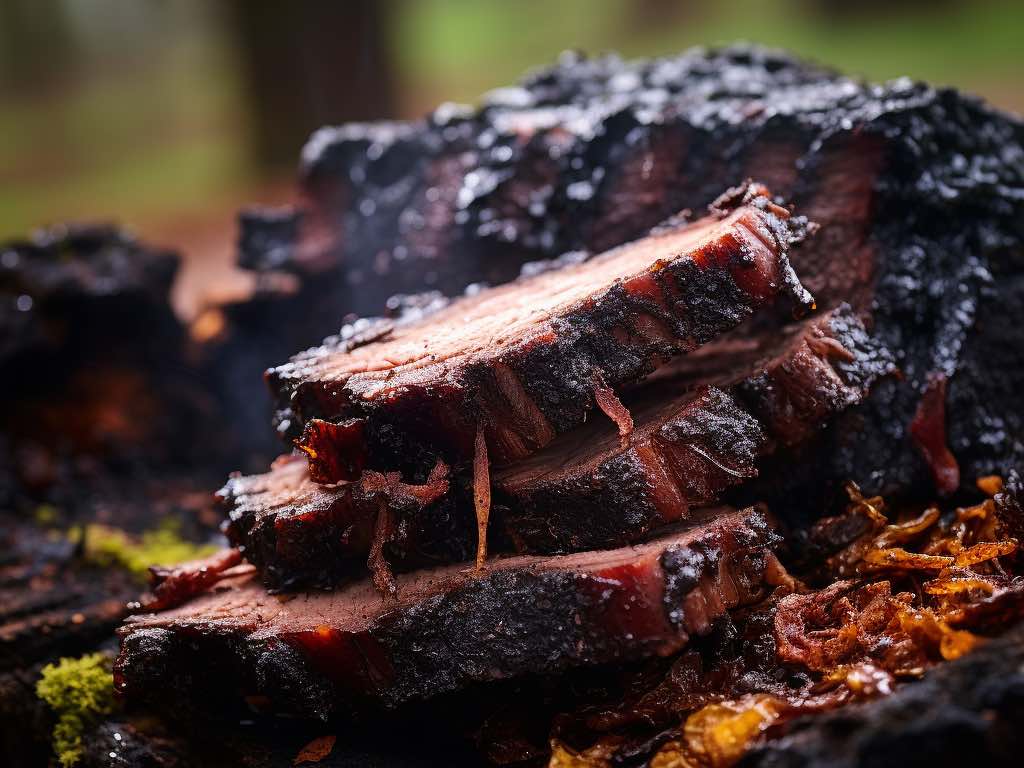
Unveiling Brisket Bark: Flavorful Crust or Culinary Masterpiece?
|
|
Time to read 6 min
Welcome to One Stop Halal!
Written by: Samir P.
|
|
Time to read 6 min
Picture this: a smoky, tender, and beautifully caramelized brisket with a crust that packs flavor in every bite. That crispy, savory outer layer is what barbecue enthusiasts affectionately call "brisket bark." It's a testament to the art and science of barbecue, and it's often the highlight of a perfectly cooked brisket. In this deep dive into the world of brisket bark, we'll explore what it is, how it forms, and the secrets to achieving the best bark possible.
Brisket bark, often regarded as the crowning glory of a perfectly smoked or slow-cooked brisket, is a culinary marvel that captures the essence of barbecue. But what exactly is brisket bark?
At its core, brisket bark is the outer layer of the brisket that undergoes a stunning transformation during the cooking process. This transformative crust results from the Maillard reaction and caramelization, two chemical processes that occur when meat is exposed to low and slow heat over an extended period.
During this journey through the smoker or grill, the brisket's surface is exposed to a medley of flavors. The rub, usually consisting of spices like salt, pepper, garlic, and paprika, plays a vital role in the formation of bark. It adds a spectrum of flavors and aids in the Maillard reaction, a complex interaction between amino acids and sugars that gives the bark its rich, savory taste and appealing color.
The infusion of smoke, another crucial component, further enhances the bark's character. As the brisket absorbs the aromatic wood smoke, it deepens the flavor and contributes to the signature smoky aroma and dark exterior that defines brisket bark.
Brisket bark is the captivating result of time, heat, spice, smoke, and chemistry, coming together to create a savory, textural masterpiece that is the highlight of any barbecue feast.
Brisket bark is a result of the Maillard reaction and caramelization. During long, slow cooking, the surface of the brisket undergoes a series of complex chemical reactions. Sugars and amino acids in the meat combine under the influence of heat to create new compounds that produce that enticing flavor and beautiful brown crust.
Achieving the perfect bark starts with the right seasoning. A rub of salt, black pepper, paprika, garlic, and other spices add layers of flavor. The spices also aid in the Maillard reaction and caramelization process.
Smoke plays a significant role in forming brisket bark. As the brisket absorbs smoke during the cooking process, it imparts a smoky flavor and contributes to the bark's rich color.
The most crucial ingredient for creating excellent brisket bark is time. Low and slow cooking allows the Maillard reaction and caramelization to occur gradually, resulting in a more flavorful bark. Aim for a cooking temperature of around 225°F (107°C).
Create a well-balanced rub that includes salt, pepper, and complementary spices. Apply it generously to the brisket, ensuring an even coating on all sides.
Maintain a moist cooking environment. A water pan in your smoker or grill can help keep the humidity level up, preventing the meat's surface from drying out too quickly.
Some pitmasters like to spritz their brisket with a flavorful liquid, such as apple juice or a vinegar-based solution, during cooking. This not only adds moisture but also enhances the flavor.
The fat cap on the brisket can aid in creating a luscious bark. Place the fat side up during cooking to allow it to baste the meat as it renders.
Once your brisket has reached its ideal internal temperature (usually around 200-205°F or 93-96°C), let it rest for at least an hour. This allows the juices to redistribute and the bark to set.
Welcome to your favorite butcher shop. We carry custom cuts of beef, chicken, lamb, goat, grass-fed beef, wagyu, deli, and more. We ship across the United States in 1-2 business days.
When it comes to barbecue, regional styles often shine through in the way brisket bark is prepared and appreciated. Texas and Kansas City are two of the most prominent regional variations in brisket bark.
In the barbecue world, these regional variations highlight the creativity and passion pitmasters bring to their craft. Whether you prefer the bold simplicity of Texas bark or the flavorful complexity of Kansas City, both styles showcase the artistry of barbecue and the endless possibilities for enhancing the humble brisket. Ultimately, it's a matter of personal preference, and each bite celebrates regional barbecue traditions.
Brisket bark isn't just a flavorful and textural delight; it's also incredibly versatile in the culinary world. This crispy, smoky layer of the brisket offers a wide range of applications beyond being a mouthwatering centerpiece. Here's a glimpse into the versatility of brisket bark:
In essence, brisket bark's versatility extends far beyond the boundaries of barbecue. Its intense flavor, smoky aroma, and satisfying crunch can elevate a wide array of dishes, turning the ordinary into the extraordinary. So, next time you smoke or slow-cook a brisket, consider the creative potential that comes with the delectable gift of brisket bark.
Brisket bark is more than just a crispy crust on your barbecue masterpiece; it's a testament to the patience, skill, and love that goes into crafting exceptional barbecue. The next time you sink your teeth into a slice of perfectly smoked brisket with that tantalizing bark, savor the flavor and artistry that brought it to your plate. Whether you're a pitmaster or an enthusiastic eater, brisket bark is a delicious reminder that the world of barbecue is a never-ending journey of flavor and texture exploration. So fire up your smoker, apply your favorite rub, and embark on your bark-filled adventure. Your taste buds will thank you.

© 2026 One Stop Halal, Inc.